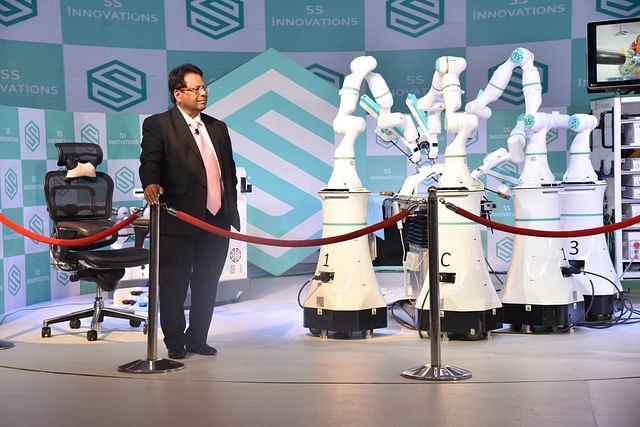
SSI MANTRA: How This ‘Made-In-India’ Robotic Surgery System Is Setting A Shining Example
The SSI MANTRA surgical robot is the brainchild of cardiac surgeon Dr Sudhir Srivastava and was developed in an Atal Incubation Centre.
It has conducted 18 successful surgeries, and the cost is likely to be one-fourth of leading global competitor.
Surgeries using a robotic system have been conducted in India for over a decade. Government hospitals of national repute as well as many private corporate hospitals have installed 72 such systems — almost all of them from a US manufacturer, who has a virtual monopoly in this arena. The 73rd such system, functioning at the Rajiv Gandhi Cancer Institute (RGCI), New Delhi, is a made-in-India product. The system was formally launched on 19 January.
It is called SSI MANTRA — an acronym for multi arm novel tele robotic assistance — and the company making it is, SS Innovations. ‘SS’ is Dr Sudhir Srivastava, India-born cardiac surgeon, who went to Vancouver, Canada at the age of 21, with a medical degree from a Rajasthan-based medical college, specialised in thoracic surgery at the University of British Columbia in Vancouver.
He then moved to Texas (US), where he performed the world’s first totally endoscopic single vessel coronary artery bypass, known as TECAB and helped created a renowned centre of cardiovascular excellence.
When robotic systems to perform surgery became available, Dr Srivastava, again performed a world-first: a quadruple TECAB on a beating heart at the University of Chicago. After performing over 1,400 robotic surgeries on the heart, Dr Srivastava decided to come home for good.
Acutely aware of the prohibitive cost of a robotic surgery system — Rs 16-20 crore by the time it lands in India, he put together a team to try and make a system, bottom up.
He roped in partners from the US, China and New Zealand — but the ticking heart of his venture was in a unit of the government-sponsored Atal Incubation Unit in Andhra Pradesh.
Four years after he founded SS Innovations, in 2016, a small team of less than 30 young Indian engineers had designed and developed the MANTRA system and a unit within the Andhra Pradesh Medical Technology Zone (AMTZ), Visakhapatnam — Asia’s first medical equipment park — was churning out the first units.
With AMTZ chief executive officer (CEO) Dr Jitender Sharma joining in from Vizag and NITI Aayog CEO Amitabh Kant, a strong supporter of the project joining in from Delhi in video links, the SSI MANTRA had its first public unveiling on 19 January, with Dr Sudhir Rawal, medical director, RGCI, sharing the experience of the institute during the human pilot trials: “I have been closely involved in the clinical trials myself, and the results have been outstanding.”
Kant added: “Designed, architectured and manufactured in India, the MANTRA system will open up a whole range of medical and robotic technologies to the Indian population.”
This is already happening: Dr Sharma confirms that the first indigenously manufactured magnetic resonance imaging (MRI) scanning system will also be launched from a unit in AMTZ in April this year.
Dr Srivastava explained that the MANTRA system had features not to be found in most other robotic surgery systems — like five robotic arms instead of four, and 3-D high-definition imaging instead of 2-D flat imagery.
“Robotics is the future of surgery, and my vision is to create a technologically advanced system that will be cost-effective, easy to use, and can be applied to all surgical specialities, benefitting most patients around the world. Compared to conventional surgery, robotic surgery results in smaller incisions, that reduces pain, scarring and leads to quicker recovery.”
SSI is yet to launch commercial operations, but Dr Srivastava says he expects MANTRA to sell for Rs 4-5 crore a unit, about one-fourth of the landed cost of the main competitor.
Tele-surgery has huge promise in India, he feels, bringing the benefits of advanced surgical care to vast unserved rural areas. Market surveys also reveal a huge export potential for the SSI system in the south Asia region, making this not just a shining exemplar of Atmanirbhar Bharat but an export candidate as well.
Replicating The Hands Of A Surgeon
Tele-robotic surgery is a method of performing a procedure using very small tools attached to a robotic arm. The surgeon manipulates the arm from a computer console. An electronic eye in the robot arm relays back a magnified high definition 3-D image. The robot replicates the surgeon’s hand movements and eliminates shortcomings like hand tremor.
The first robotic surgery in India was performed in AIIMS, New Delhi in July 2006 using a US-made Da Vinci system (the most-widely used robotic surgery system).
The first robotic coronary surgery in India was performed in December 2018 at the Apex Heart Institute, Gandhinagar, on a patient 30 kms away, using a system from Corindus Vascular Robotics, a Siemens company.
Worldwide some 6,000 robotic surgery systems are known to be at work with 4,000 in the US alone.